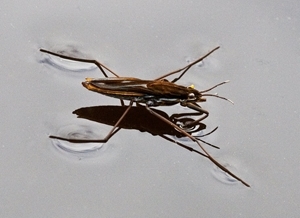Pond skater (Gerris lacustris)
 Having fallen into the water, they both turned and started to swim for the shore. The bigger, stronger one made dry land first and, on clambering out, turned to see the most horrific sight. Striding across the water’s surface – literally walking on top of the water – came a huge monster, with great long legs and an extended beak-like face. It was making straight for the struggling swimmer. As he watched helplessly from the shore, he saw the monster grab the swimmer with its front legs and then jab its long pointed beak into him, whereupon it proceeded to suck the very life out of the now limp body!
Having fallen into the water, they both turned and started to swim for the shore. The bigger, stronger one made dry land first and, on clambering out, turned to see the most horrific sight. Striding across the water’s surface – literally walking on top of the water – came a huge monster, with great long legs and an extended beak-like face. It was making straight for the struggling swimmer. As he watched helplessly from the shore, he saw the monster grab the swimmer with its front legs and then jab its long pointed beak into him, whereupon it proceeded to suck the very life out of the now limp body!
A made up horror story, pure science fiction of course! Well no actually, in fact this very scenario is performed everyday for real across our waterways throughout the summer, right here in Britain! The monster is a pond skater (Gerris lacustris), a fearsome predator of any small insect that may be unfortunate enough to take a tumble from an over-hanging tree or get blown off direction and land up near to this marauding killer.
Pond skaters can be found on ponds, lakes or brackish water throughout Britain and have thin, brownish-grey bodies and small heads with large eyes. Most species have wings to enable them to colonise other areas of water and to leave the water altogether in the winter, to hibernate on dry land.
They use their six legs for different tasks; the two shorter front legs are used for clasping prey, and in the case of the male, for holding the female while mating. The middle pair of legs is used in a rowing action, propelling them forward, often at great speed – up to 1.5 metres per second! The back legs act as rudders to help steer the insect across the water and all six legs and the body are covered in dense velvety hairs which help to detect tiny vibrations or ripples moving across the water’s surface, alerting them to a drowning prey item. They are also very useful in that they will help to detect mosquitoes as they emerge from the water, catching many of them before they can take to the air. Skaters have enemies too though and the hairs help them to detect danger, so that not only can they move away with pace, but in some circumstances they can jump to make their getaway.
The skater’s hairy legs are also used to create their own signals across the water’s surface to communicate with other skaters. A male can send out ripples with a frequency of 35-45 hertz telling other nearby males not to come any nearer, while also informing females on a frequency of 2-5 hertz that there is a fine skater with an excellent territory over here, which not only can attract her to him, but also stimulates her to lay eggs!
These same hairs are also vital in helping the skater to support itself on top of the water by using the surface tension to stop it breaking through into the water itself. Pond skaters have been marvelled at for a long time and have accordingly been given many names such as water striders, water bugs, magic bugs, skimmers, water scooters, water skaters, water skeeters, water skippers and even the rather crass name of "Jesus” bug!
Fossil finds show us that these dashing little predators have been living on the surface of our water, hunting down their prey for around 55 million years. So, perhaps the next time you pass a pond, which will almost certainly have few skaters present, why not stop and watch them for a while, they are amazing after all!
Peter Thompson
Advisory
Read more from Peter Thompson at the Fresh from the Field blog.

Download Peter Thompson's essential 26-page book, featuring beautiful photography and detailed profiles of Britain's wildlife
Download FREE >